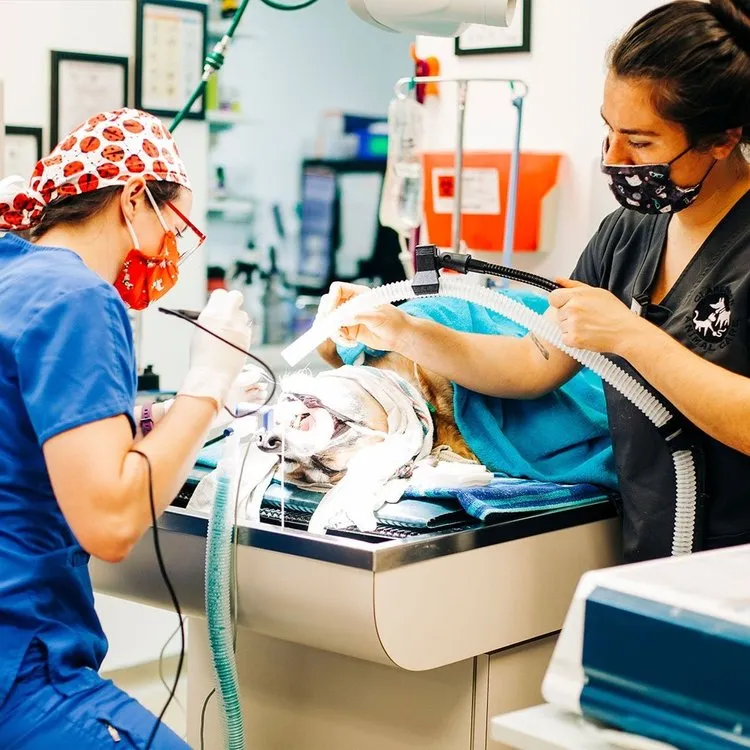
My pet is having surgery, how can I prepare?
It’s a big day – your pet is having surgery. Whether it’s routine neuter or a more complicated procedure, surgery days are understandably a source of anxiety for many pet owners. Taking time to prepare ahead can make for a smooth experience!
What’s involved in my pet’s procedure day?
Examination: If a patient is having an anesthetic procedure, we advise an exam within no more than two months prior. Often times, we’re making a recommendation for a dental procedure or anesthetic procedure based on findings at an annual or biannual exam, and would set up the procedure within an appropriate time-frame.
Preoperative Bloodwork: This helps us to evaluate a patient’s metabolic function, as well as their cell lines. We want to make sure our patients are metabolically stable prior to anesthesia and surgery, and if they do have underlying conditions we want to be sure we are aware of them ahead of time so we can use the most appropriate anesthesia drugs and best manage the disease state. We may perform this at the time of the initial examination, or as a technician appointment closer to the time of the procedure (but within no more than two months).
These handouts go into more detail about the Routine CBC and Chemistry Panels.
Premedication: This refers to medications given ahead of the induction of anesthesia to provide relaxation and sedation, anti nausea effects, and pain control if the procedure is anticipated to be painful. It is very well-documented that having pain control on board ahead of a potentially painful stimulus is much more effective than trying to catch up with it afterwards. Additionally, when we utilize a combination of medications we are able to get synergistic effects while also minimizing side effects of an individual medication used at a higher dose. The vast majority of drugs utilized in our patients are the same or very similar to what we would receive if we were undergoing anesthesia or surgery ourselves.
Intravenous Catheter: During general anesthesia we want to have intravenous access in order to quickly and efficiently administer additional anesthesia drugs as needed, emergency drugs as needed, and to administer intravenous fluids to maintain hydration.
Because placement of an intravenous catheter can be a bit stressful for many patients, we typically do this after they have received the premedication above.
General Anesthesia & Monitoring: This step typically begins by administering a drug to induce an unconscious state. We then place an endotracheal (“ET”) tube in the trachea or main airway so that we can administer oxygen and the anesthesia gas, which keeps the patient unconscious, as well as administer breaths to the patient as needed. In most cases the patient will maintain respiration on their own, as the breathing mechanism is still intact; however, we also have the ability to mechanically ventilate our patients, which is especially beneficial in certain underlying disease conditions and with longer procedures.
One of the most important aspects of the entire surgical and anesthetic process is diligent monitoring of the patient during all phases of the procedure. Our team utilizes highly trained licensed veterinary technicians, as well as the most up-to-date monitoring devices – we utilize many, if not all, of the same monitoring tools as we would be monitored with for our own procedures, though a trained and competent team member will always be the best monitoring “device”!
Recovery Monitoring: It is often said that recovery is the most critical time during an anesthetic procedure. Our patients are closely individually monitored by a highly trained veterinary team member during the critical recovery period.
We will be closely monitoring vitals such as temperature, respiratory rate, heart rate, and if needed blood pressure, during this period.
Pathology Submission: if any abnormal tissues were removed during the procedure, these are submitted to a veterinary pathologist so that we may get a definitive diagnosis on the type of tissue involved.
Suture Removal / Dental Recheck: If a patient has had a procedure done with our team we typically will recommend a courtesy post-operative visit for suture removal and/or recheck of extraction sites.
For more information read our FAQs about preparing for your pet’s procedure. Please do not hesitate to ask questions about your pet’s upcoming anesthetic procedure – we want to be sure you have all your questions answered!
“Just wow. We had an emergency with one of our kittens and called four places and the emergency vet and none could take us.
Clarendon Animal Care was so empathetic and agreed to take us at the end of the day. Every staff member-reception, techs, the vet—were so upbeat and friendly.”
— Emily Butler | Google Review
Veterinarian Careers – North Arlington
Hospital Support Careers – North Arlington
